“I have a British background and I have always had tea and something sweet. First time I tried this clotted cream I almost ate the entire jar by itself, it is that good!” ~Kim

If you’ve never had a classic English afternoon tea with scones and clotted cream, you’re missing out!
Last week I was treated by the historic Biltmore Hotel in downtown Los Angeles to their classic English afternoon tea. If you’ve never had a classic afternoon tea, you need to experience it. The highlight of any afternoon tea, besides the tea, is the array of tiny treats that comes with it, and I always zero right in on the scones and clotted cream. (That’s them on level two of our 3 tiered tea tray.)
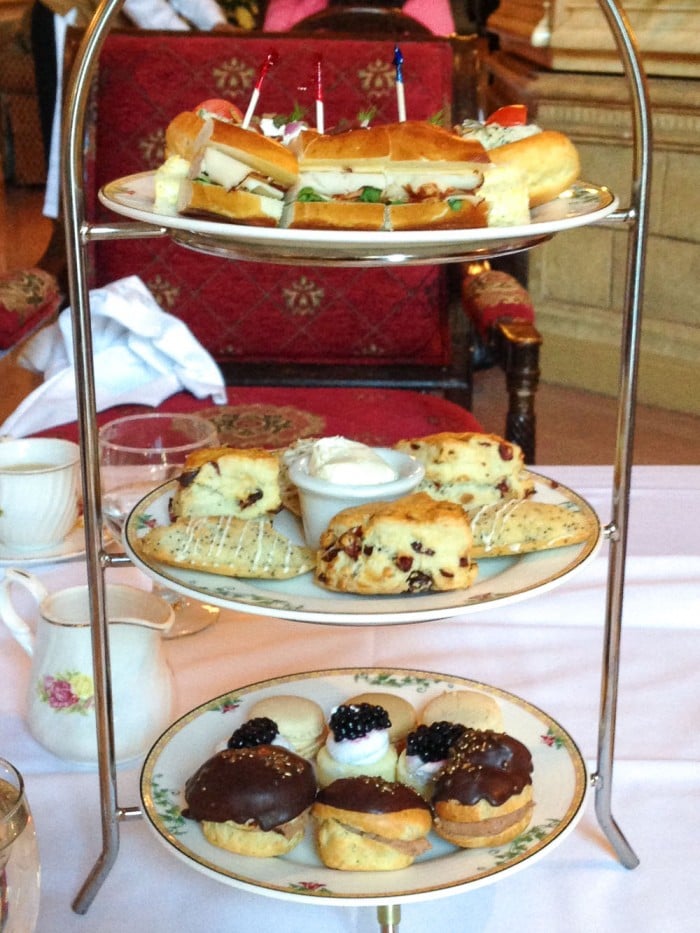
What is Clotted cream?
If you’ve never had it, clotted cream is a very thick rich spreadable form of heavy cream that was first invented ages ago by some very smart British farmers. Traditionally cream heated until it thickens and develops a slightly nutty flavor. Clotted cream has a high fat content (around 55-65%) and a dense texture. It’s not like whipped cream, or cream cheese, it’s not like butter…it has a unique decadent consistency and a wonderful soft flavor. It’s quite thick and spreadable, and when you slather it on a freshly baked scone there is no better thing in the world.
The little pot of clotted cream that we got at the Biltmore had me craving more, and happily I made the most astounding discovery…you can actually make clotted cream at home in your own kitchen. No more tracking it down in specialty stores and paying big bucks for the imported stuff. My homemade clotted cream was actually way better (and a whole lot fresher) than the British stuff I usually buy.

What does clotted cream taste like?
Clotted cream has a rich, creamy taste with a slightly nutty ‘cooked’ flavor. It’s luxurious and indulgent, with a dense, velvety texture that is thicker and creamier than regular whipped cream. Clotted cream is also slightly sweet, but not as sweet as whipped cream or frosting, with a delicate flavor that pairs well with desserts, fruit, and scones. The crust on top of the clotted cream adds a slightly caramelized and nutty flavor, which many people find particularly delicious. The mouthfeel of clotted cream is a key part of its charm, and is like nothing else you’ve ever had!
what you’ll need
- heavy or whipping cream that has not been ultra-pasteurized
- This is cream that has been pasteurized, but not ultra-pasteurized. Ultra-pasteurized cream is cream that has been heated to a higher temperature than regular pasteurized cream to extend its shelf life.

How to make clotted cream
This is an amazing process, I hardly had to do anything, and I end up with a ton of the richest, silkiest clotted cream I’ve ever had.
- I used 2 pints of (non-ultra-pasteurized) heavy cream.
- I poured them into a baking dish, and left it overnight in a 180F oven (the lowest my oven will go.)
- In the morning I let it cool and then refrigerated it for the rest of the day.
- Then I scooped it into jars, which was a little sloppy at first, and put them back in the refrigerator. Any little bit of liquid gets absorbed right into the clotted cream after you put it in the jars, and by the next morning when I had it with my scones, it was absolutely to die for.
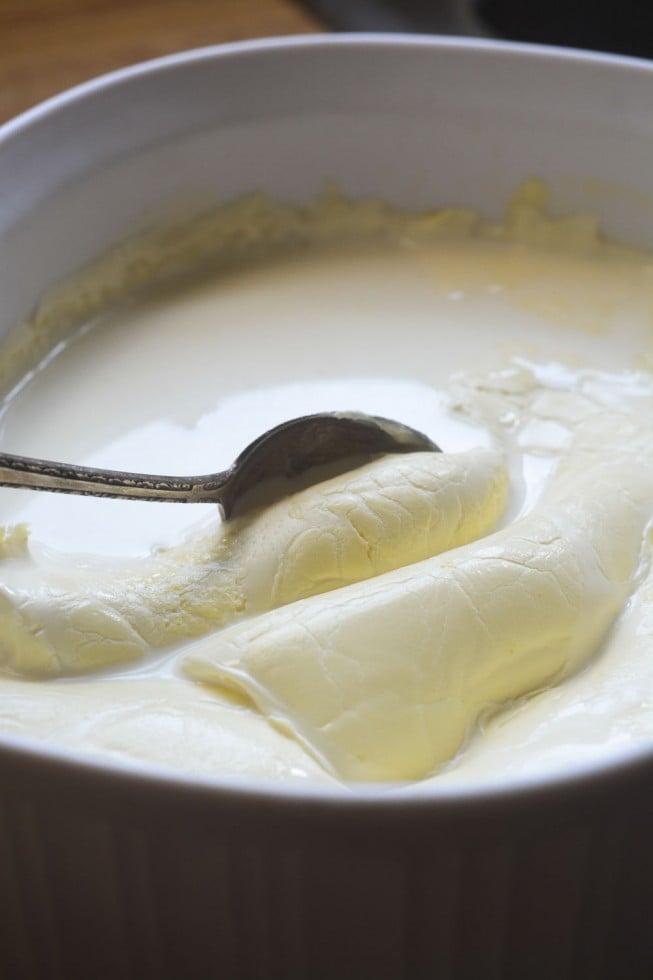
How long does clotted cream last?
Homemade clotted cream can last for up to 3-4 days when stored properly in the refrigerator. To extend its shelf life, it’s important to keep it in an airtight container and store it in the coldest part of the refrigerator, such as the back of the bottom shelf.
It’s important to note that clotted cream does not have any preservatives, so it should be consumed as soon as possible for the best flavor and texture. If you notice any changes in color, texture, or odor, discard the clotted cream immediately as it may have spoiled.
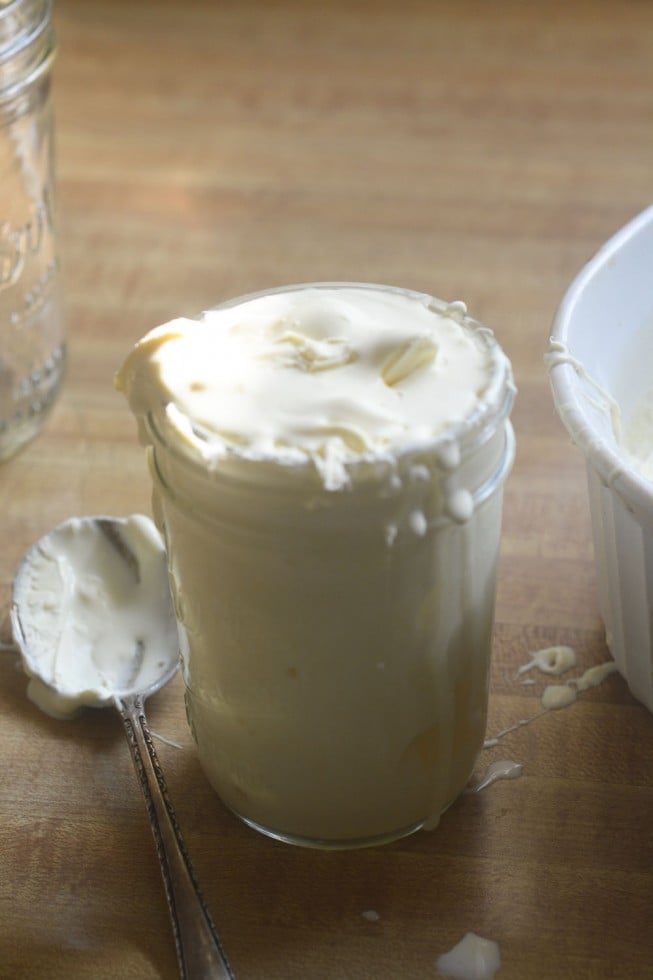
What to do with the leftover whey from making clotted cream
The leftover whey from making clotted cream can be used in a variety of ways:
- Adding it to smoothies or protein shakes for a boost of protein and nutrients.
- Using it as a substitute for milk or water in baking recipes such as bread, muffins, and pancakes.
- Using it as a marinade for meat or fish to tenderize and add flavor.
- Adding it to soups or stews for added richness and flavor.
- Using it as a liquid base for making homemade ricotta cheese or other soft cheeses.
- Feeding it to pets, as it is a good source of protein and nutrients for animals.
Note: It’s important to keep in mind that the leftover whey should be used or stored promptly to avoid spoilage. It can be stored in the refrigerator for up to a week or frozen for longer storage.
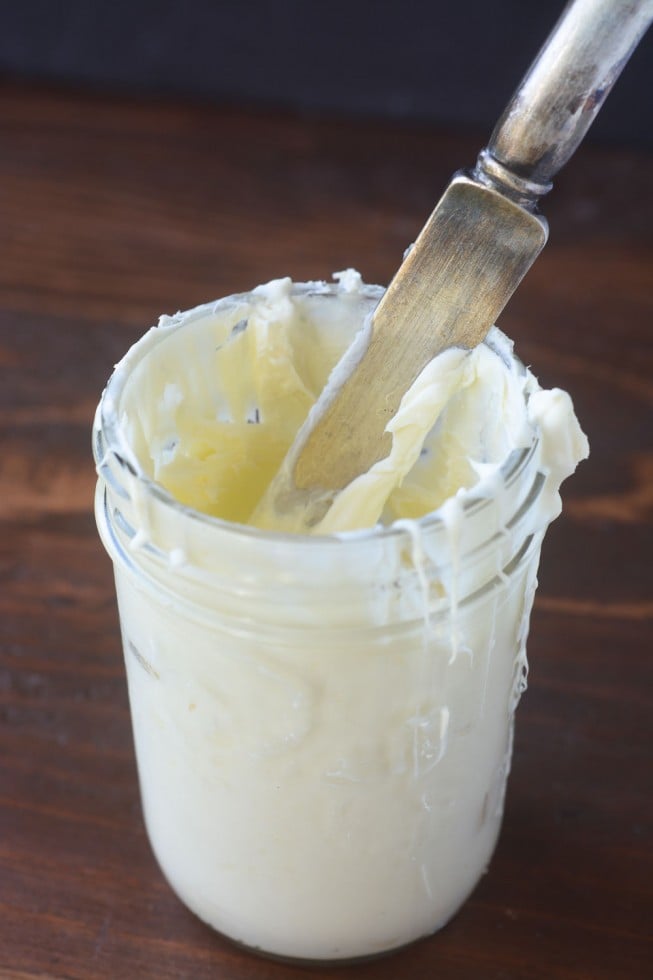
I can’t say enough good things about this project, the results far exceeded my expectations and it was absurdly easy. The only catch is that you can’t use ultra-pasteurized cream, which is cream that’s been processed for a longer shelf life. Many stores only sell ultra-pasteurized cream, so you have to search a bit for regular cream. I found mine at Whole Foods. Just read the labels… if it doesn’t say ultra-pasteurized on the label, you’re good to go.
can you make clotted cream with ultra-pasteurized cream?
Some readers in the comments below have had success with ultra-pasteurized cream. It is possible to make clotted cream from ultra-pasteurized cream, but it may be more difficult to achieve the desired texture and flavor. Ultra-pasteurization is a process that heats the cream to a higher temperature than regular pasteurization, which extends its shelf life but can also alter the proteins and enzymes in the cream. This can make it more difficult for the cream to form clots, which are necessary for making clotted cream.

What to eat with your homemade clotted cream
You will definitely want to make scones to go with your homemade clotted cream. I have lots of recipes for scones on the blog, but a simple one to start with is my Classic Cream Scones Recipe.
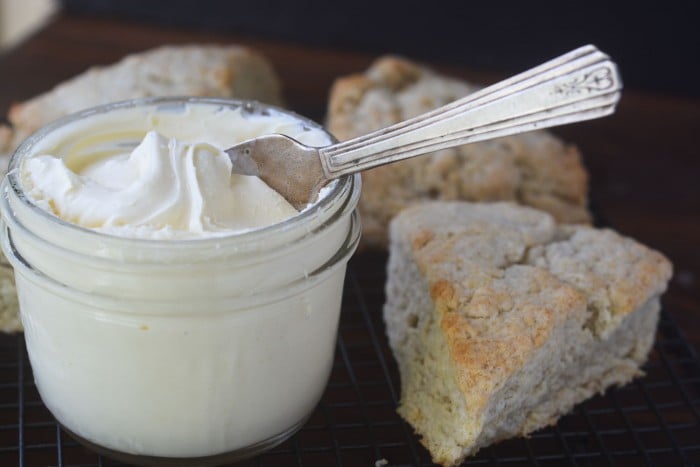
Tips for making clotted cream
- Make sure your cream is not ‘ultra pasteurized’, you will need to find regular pasteurized cream at a Whole Foods or other similar store. Ultra pasteurized cream has been treated in a way that prevents it from ‘clotting’.
- An oven thermometer is an essential kitchen tool, and really comes in handy for this project. If your oven is too cool or too hot your homemade clotted cream will not ‘clot’. Set your oven to 180F and then check the thermometer. You can adjust up or down as necessary.
- If your oven does not go down as low as 180F you can try one of my other methods for making clotted cream:

Homemade Clotted Cream
Video
Equipment
- a heavy casserole dish
Ingredients
- 2 pints heavy cream or whipping cream (double cream in the UK), avoid ultra-pasteurized cream for best results.
Instructions
- set your oven to 180F
- Pour the cream into the casserole dish. It should come up about 1-3 inches on the side.
- Set the dish, uncovered, in the oven and leave undisturbed for 12 hours. Be sure to leave the oven on the whole time. I do this overnight.
- Remove the dish from the oven and set to cool. Then cover and refrigerate. Note: the cream may seem thin at this point, but is going to thicken considerably overnight.
- The next morning scoop the thickened cream into a jar or jars, and cover and put back in the refrigerator. You can use the leftover cream for baking..
- Spread the clotted cream on freshly baked scones.
Nutrition























Hello,
Can it be “cooked” directly in 4oz jars, (and then stored in the refrigerator) for avoiding the transfer after it’s done?
Great question Zaf! I haven’t tried to do it this way but I don’t think it will work. The process seems to be very particular and needs a certain volume (and depth) of cream plus an exact temperature to “clot”. I think if the cream were in small jars the temperature within the jars would be higher, for one thing.
It might be worth a try, but I can’t guarantee success!
I tried the stove top recipe and even boiled it longer than the 30 min but mine never really got thicker much at all but I still poured it in the dish and put it in the fridge and went back after few hours and it’s still mostly liquid. What did I do wrong. I searched all over town for some of the right cream and found some at our coop that said pasteurized at a low temp so I’m not sure if it had something to do with that or what the problem is. I’m sad I wanted it for my daughter’s bridal shower tea party Saturday please help
I can’t be sure what went wrong, but I can only imagine that it has something to do with your cream…maybe it’s lower in fat than others? I think with the stove top method you can go with a more standard cream, make sure it’s labeled “heavy cream” which is at least 36% fat. And if you are simmering slowly you may need to boil longer. Remember it thickens completely after chilling overnight, so that’s important.
There is a local brand of cream here that I have to avoid buying because it will not whip. And I’m wondering if it’s the same with your coop cream. Some are just not high enough in fat. Hope this helps ~ I’d try a regular cream, even if it is ultra-pasteurized, because with the stove top method it’s simply a matter of evaporation.
Thank you for this recipe. It was very straightforward, and easy to follow.
I just made it for the first time, and I am wondering if I did something wrong because mine form a light golden crust on top that I’m worried will creat a lumpy texture in the final product. I have it in jars in the fridge currently, and added the leftover whey to my jars, so I’m wondering two things:
1) Is there supposed to be discoloration/a crust on top?
2) Can the chunkiness from the crust somehow be smoothed out before serving?
My clotted cream tasted great, but turned out too thick and crumbly. Any suggestions?
It sounds like maybe it got cooked too long or at too high a temp. Also that can happen if your cream isn’t deep enough in your dish. What you can do is stir some of the whey back into the clotted cream to thicken it up. You can even very briefly blend it together with the whey.
In the recipe instructions it says to bake the cream for 12 hours UNCOVERED, but in the short video you cover the pot. Can you please confirm which is correct ? Thanks so much.
I do it uncovered, but it works either way. Uncovered, depending on your pan and oven, can result in more of a ‘crust’, which many people prize.
I was thrilled to find this recipe and couldn’t wait to try it out. I’m not sure what I’m doing wrong, but I’ve tried 3 times and haven’t had the success everyone else has. I get a thick layer of cream, but underneath that is liquid. Wondering if there’s something off with my oven temps. I even tried different dishes to bake it in (first attempt was with a Le Creuset, which I realised was the wrong choice).I’m not giving up now that I see there’s a stovetop method 🙂
If you’re having trouble with this recipe Karen it’s probably your oven temp. I suggest using the stove top method, it’s less fussy.
You’re doing it right. You’re supposed to have the liquid underneath the cream. That’s the whey that has separated. Pour it off and put the cream in the fridge for another 12-24 hrs. Save the whey to use in recipes calling for milk or water. It is very nutritious.